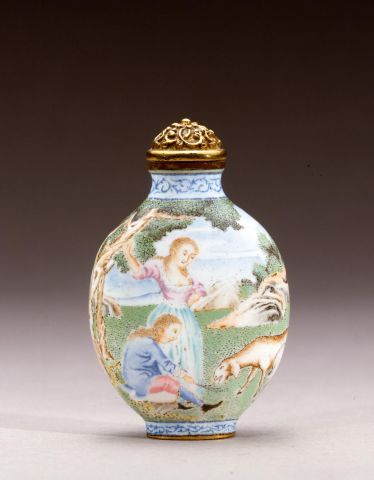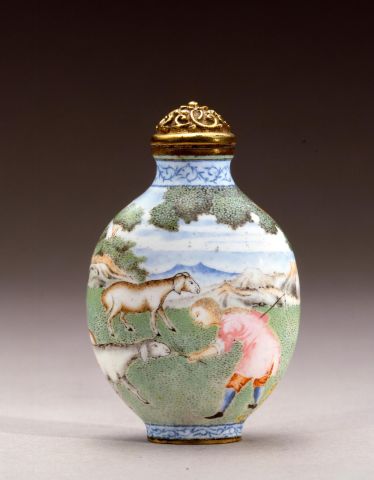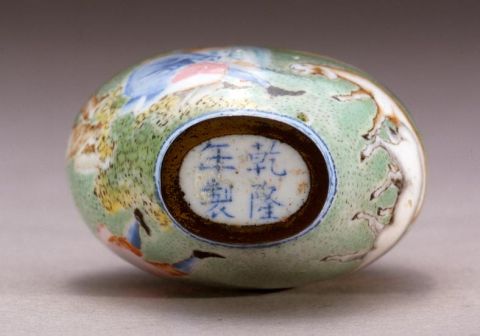


Bottle ID: 00049
GUANGZHOU, SMALL EUROPEAN FIGURES W/MARK
Date: 1736-1795
Height: 48 mm
Enamels on copper, of ovoid form tapering to an everted mouth, painted on one side with a seated European gentleman feeding a goat and European woman standing behind him leaning against a tree with rocks amongst the grass behind them; the reverse with a European youth tending to two goats on a grassy hillside with a mountain range in the distance; the neck and foot with a scrolling band; the base with a blue enamel four character Qianlong nianzhi mark in regular script and of the period.
Probably Imperial, attributed to the Guangzhou Workshops, Guangzhou.
Similar Examples:
Hughes, Michael C. The Blair Bequest - Chinese Snuff Bottles from the Princeton University Art Museum, 2002, pp. 248-249, no. 347.
Hui, Humphrey K. F. and Christopher C. H. Sin. An Imperial Qing Tradition - Chinese Snuff Bottles from the Collection of Humphrey K. F. Hui and Christopher C. H. Sin, 1994, p. 157, no. 190.
Sotheby's, Hong Kong, May 2, 1991, lot 85, The Collection of Arthur Gadsby.
Provenance:
Clare Lawrence Ltd.
Sotheby's, New York, November 22, 1988, lot 22
The Bai Shi [Karel Bass] Collection
Arthur Gadsby Collection [by repute]
Exhibited:
Annual Convention ICSBS Toronto, 2007
Detroit Museum of Art, April-October, 1986
Flint Museum of Art, 1979
Enameling on metals, glass and ceramics began during the reign of Kangxi when the Emperor set up workshops in the Palace for producing works of art, including snuff bottles. Although no archives exist for the Kangxi period (as they do for the following two reigns of Yongzheng and Qianlong), it is understood that the first enamel on copper snuff bottles were produced around 1716. An enamel on metal snuff bottle would pass through a number of different workshops in the Palace during its manufacture. The copper body would be produced in the metal workshopsand then would be sent over to the enamel workshops to be decorated and fired. The stopper and spoon would have been made elsewhere.
Even without any archives, it is evident from the amount of extant enameled metal works of art, that snuff bottles were made in greater numbers than other pieces. This continued under the Yongzheng Emperor who in 1725, in the third year of his reign, ordered that the workshops produce both "regular" orders and "festival" orders. The "regular" orders were made for Imperial use, while the "festival" orders were for festivals such as "New Year" and the "Dragon Boat Festival". It is not clear where pieces ordered for "bestowal" fit into this classification. This practice continued thoughout the Qianlong period. During the reign of Jiaqing, the Archives of the Imperial Household Department show only "festival" orders being made until 1813, when the Jiaqing Emperor ordered an end to the production of this type of enameled bottle.
In the majority of cases, most "Imperially" made enamel on metal snuff bottles are executed with individual designs, with very few being made more than once. Often the form would dictate the style of decoration, with the classic flattened rounded shape being the usual type. A bulbous or cylindrical form would be more likely to have a continuous scene enameled upon it. The base mark on this bottle is atypical of the group, as the marks are generally executed in seal script and in enamel colors of either blue, black, red or gold.
< Back to full list

 English
English 中文
中文